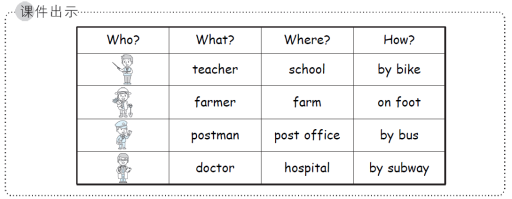人教pep六上英语 Unit 5 The fourth period第四课时教案
The fourth period(第四课时)
Part B Let’s learn & Write and discuss ![]()
▶教学内容与目标
课时教学内容 | 课时教学目标 |
Let’s learn | ·通过图片、课件等,结合教材中Oliver和吴一凡谈论自己家人工作的情景学会听、说、读、写有关职业的单词:fisherman, scientist, pilot, coach ·能够熟练运用上述单词,并能结合本部分核心句型“What does he/she do?”“Where does he/she work?”来询问职业和工作地点 |
Write and discuss | ·能够在图片的提示下写出四种职业的名称,为其选择工作地点 ·能够根据完成的内容就四人的职业和工作地点进行交流 |
▶教学重点
能够听、说、读、写并熟练运用下列有关职业的单词:fisherman, scientist, pilot, coach。
▶教学难点
能够用所学有关职业的词汇和句型来谈论他人职业和工作地点。
▶教学准备
PPT课件、课文录音、视频、教学卡片等。
▶教学过程
1
Step 1: Warm-up & Revision & Lead-in
1. Greetings.
 2. Revision.
2. Revision.
Show some pictures and word cards on the PPT. Help students review the words of the jobs.

Ask students to talk about them and review the key sentences in pairs.
3. Free talk & Lead-in.
Talk about students’ parents’ jobs, workplaces and the ways to work.
T: Do you know any other jobs? There are more jobs around us. They’re very cool! Let’s go and have a look.
Write down the topic “What does he do?” on the blackboard.
 Step 2: Presentation
Step 2: Presentation
1. Look and learn.
Present the pictures on the PPT. Lead students to learn the new word “fisherman”.(课件出示:教材P51 Let’s learn板块的图片)
T: What does Mike’s uncle do? Do you remember? Please circle the right picture.
Students look at the pictures carefully and find the right picture.
Write down the word “fisherman” on the blackboard. Use the recording to teach the word.(出示课件)
Then write down the word “fisherwoman” on the blackboard. Students try to read by themselves.
Point to the picture and practice the word in pairs like this:
A: What does he do?
B: He’s a fisherman.
A: Where does he work?
 B: He works at sea.
B: He works at sea.
2. Listen and learn the dialogue. Learn the word “scientist”.
T: Oliver and Wu Binbin are talking. Who are they talking about? What does he or she do? Now let’s listen.
Play the recording and lead students to answer the questions.(课件出示:教材P51 Let’s learn板块的音频)
T: Who are they talking about?
Ss: They are talking about Oliver’s aunt.
T: What does she do?
Ss: She is a scientist. She teaches science.
T: Yes! Where does she work? … She works at a university.
Show a picture of a university on the PPT and teach the word “university”.(课件出示:university的相关内容)
Show the picture to students.(课件出示:教材P51 Let’s learn板块的图二)
Write down the word “scientist” on the blackboard. Help students learn the word by comparing with the word “science”. Use the recording to teach the word. (出示课件)
Show some scientists’ pictures on the PPT. (课件出示:一些科学家图片,如:袁隆平,钱学森,李四光,竺可桢,邓稼先)
Students practice the word and the dialogue in pairs.
A: Who’s that man?
B: He’s… He’s a famous scientist.
3. Learn the word “pilot”.
T: Look at Picture 3. There is a woman. She’s so cool! She works on a rescue plane. What does she do? Let’s listen.(课件出示:救援飞机的图片及词汇)
Write down the word “pilot” on the blackboard. Teach the word to students.(课件出示:pilot的相关内容) Lead them to read the word one by one.
Point to the picture and practice the word in pairs like this:
A: What does she do?
B: She is a pilot.
A: Where does she work?
 B: She works on a rescue plane.
B: She works on a rescue plane.
4. Learn the word “coach”.
T: (课件出示:教材P51 Let’s learn板块的图四) Look at Picture 4. There is a man. He’s strong. What does he do?
Students look at the picture carefully and try to spell the word.
Show the word “coat” to help them spell the new word “coach”.
Write down the word “coach” on the blackboard. Teach it and lead students to read the word one by one.(课件出示:coach的相关内容)
Point to the picture and practice the word the same as above.
Students practice in pairs.
5. Read the words.
Play the recording of “Let’s learn”.(课件出示:教材P51 Let’s learn板块的音频)
 Students read after the recording. Then students practice the words by themselves. The teacher gives help when they need.
Students read after the recording. Then students practice the words by themselves. The teacher gives help when they need.
Step 3: Practice
1. Play the game: High voice and low voice.
Use the word cards to play this game.
The teacher shows one card to students. Students read the corresponding word right away. If the teacher raises the card up, students should read the word in a higher voice. If the teacher brings the card down, students should read the word in a lower voice.
2. Sharp eyes.
Use the PPT to play a game. Students read the words or the phrases as fast as they can.(课件出示:本课学习的单词或词组,一个接一个快速滑过屏幕)
3. Pair work.
Students look at the pictures of “Let’s learn” in the book and ask and answer in pairs.
A: What does he/ she do?
B: He/ She is a…
Step 4: Consolidation & Extension
“Write and discuss”
1. Create a situation.
T: There are some cool persons around us. Let’s go and have a look.
2. The places where people work.
Show the pictures and the words of “pet hospital, university, gym, sea, plane” on the PPT. (课件出示:宠物医院,大学,体育馆,大海,飞机词汇及其图片) Ask students to match the words with the corresponding pictures.
Show a picture of a gym on the PPT to help students to understand the word “gym”. Teach them to read the word. (课件出示:体育馆图片)
 3. People work in these places.
3. People work in these places.
The teacher points to the pictures and asks some students to answer the questions.
T:(Point to the picture of the pet hospital.)Who works in a pet hospital?
S1: A doctor. He works in a pet hospital.
T:(Point to the picture of the university.)Who works in a university?
…
4. Finish the task.
Ask students to complete the sentences of “Write and discuss” in the book.
5. Check the answers.
6. Talk about other jobs.
T: Can you think of any other jobs? Where do those people work?
Students talk about other jobs.
S1: My aunt is a cleaner. She works in a company.
…
Show the picture of the main scene to students. (课件出示:Unit 5主情景图) Talk about the picture with students. Help students know something about “rescue”.
T: Orange is often used for emergency rescue clothes and equipment in many countries, such as life jackets, lifeboats, firemen’s clothes and engineering emergency vehicles.
1
▶板书设计

▶作业设计
Copy the words 3 times.
▶教学反思
1. 借用PPT出示相关职业、工作地点和上班方式的单词卡片,帮助学生复习与职业相关的词汇及句型,激发学生的学习兴趣,为后面的学习做好铺垫。
2. 充分结合图片和对话引导学生学习新单词。借用多媒体教授新单词,多种方式引导学生操练新单词。
3. 在情境中理解,在活动中运用,突出语用功能。通过创设合理情景,帮助学生在情景中真实自然地使用所学语言,突出教学重点。
4. 注重话题的延续性,由讨论图片上的人物到讨论学生家长的话题,再到讨论“Mike’s uncle”和“Oliver’s aunt”,然后到书上的五个人物,这样自然过渡,将整堂课串成一个有机整体。
5. 帮助学生了解橙色多用于各国紧急救援的衣服和设备上,如:救生衣、救生艇、消防员衣服和工程抢险车等。
![]()
▶Teaching Contents & Teaching Aims
Let’s learn
·Be able to listen, speak, read and write the new words “fisherman, scientist, pilot, coach” by talking about the pictures and the PPT.
·Be able to use the above words skillfully and talk about the jobs and the workplaces by using “What does he/she do?”“Where does he/she work?”
Write and discuss
·Be able to write down the names of the four jobs with the help of the pictures and choose the workplaces for them.
·Be able to communicate with each other about their careers and workplaces according to the completed contents.
▶Teaching Priorities
·Be able to listen, speak, read, write and use the new words “fisherman, scientist, pilot, coach”.
▶Teaching Difficulties
· Be able to talk about other people’s careers and workplaces by using the language they have learned.
▶Teaching Procedures
Teaching Stages | Teacher’ s Activities | Students Activities | Teaching Purposes |
Warm-up & Revision & Lead-in | 1. Greetings. 2. Revision. Show some pictures and word cards on the PPT. Lead students to review the sentences. 3. Free talk & Lead-in. | 1. Greetings. 2. Review the words of the jobs. Talk about them to review the sentences. 3. Talk about their parents’ jobs and workplaces. | Review some words and the sentence structures of talking jobs and workplaces. Prepare for the following study. |
Presentation | 1. Look and learn. Present the pictures on the PPT. Teach the word “fisherman”. Point to the picture and practice the word in pairs in sentences. | Look at the pictures carefully and find the right picture. Learn and practice the new word in pairs, in groups. | Deepen students’ impression of the new word by reviewing what they learned in the last class and practicing with the key sentence structures. |
2. Listen and learn the dialogue. Learn the word “scientist”. | Listen to the recording and answer the questions. Learn the word “scientist”. Practice the word and the dialogue in pairs. |
|
(续表)
Teaching Stages | Teacher’ s Activities | Students’ Activities | Teaching Purposes |
Presentation | 3. Learn the word “pilot”. Show Picture 3 and a picture of rescue plane. Play the recording of “pilot” and teach the word. | Look at the pictures carefully Learn the new word and read it one by one. Practice in pairs. | Lead in the new words properly. Help students learn the new words through the pictures and the questions. Show some pictures of famous Chinese scientists to help students stimulate their patriotism and national pride. |
4. Learn the word “coach”. Show Picture 4 and show the word “coat” to help students spell the new word “coach”. Then teach the word. | Look at the picture carefully. Read the word “coat” and try to spell the new word “coach”. Point to the picture and practice the word the same as above. | ||
5. Read the words. Play the recording. Give help when necessary. | Read after the recording. Then practice the words. | Lead students to read the words by themselves. Elevate students’ learning initiative. | |
Practice | 1. Play the game: High voice and low voice. 2. Sharp eyes. 3. Pair work. | 1. Read the words in a higher voice or a lower voice according to the teacher’s actions. 2. Read the words or the phrases as fast as they can. 3. Look at the pictures of “Let’s learn” and ask and answer in pairs. | Enliven the class. Help students practice the words in different ways. Stimulate students’ learning interest. |
Consolidation & Extension | “Write and discuss” 1. Create a situation. 2. The places where people work. Show the pictures and the words of some places. 3. People work in these places. 4. Finish the task. 5. Check the answers. 6. Talk about other jobs. | Match the words with the corresponding pictures of the workplaces. Talk about the people working in these places. Write down the words and complete the sentences of “Write and discuss” in the book. Check the answers. Talk about other jobs. | Create a real situation to develop students’ comprehensive language using ability. Help students understand that orange is often used in emergency rescue clothes and equipment in many countries. |
Homework | 1. Copy the words 3 times. 2. Do the exercises. | ||
1
